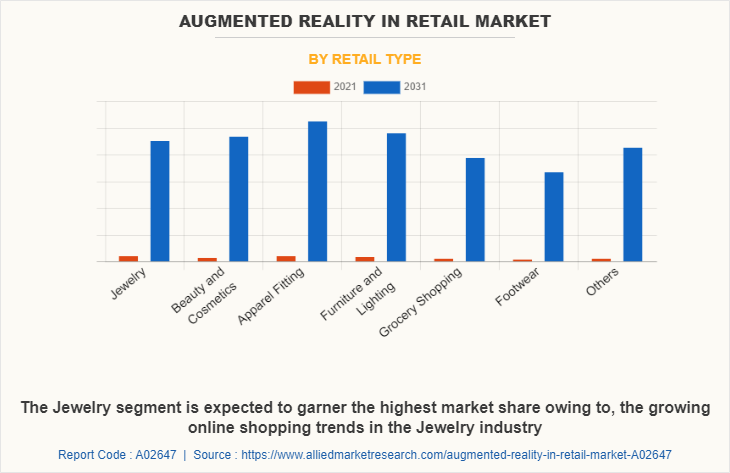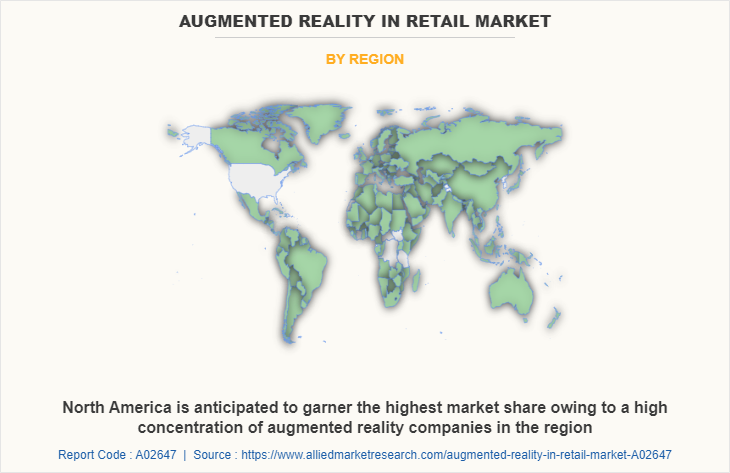Augmented Reality In Retail Market Research, 2031
The global augmented reality in retail market size was valued at $2 billion in 2021, and is projected to reach $61.3 billion by 2031, growing at a CAGR of 41.4% from 2022 to 2031.
Rise in investments in the AR market and increase in penetration of smartphones boost the growth of the global augmented reality in the retail market. In addition, the cost-efficient benefits of augmented and virtual reality-based solutions positively impact the growth of the market. However, security and privacy concerns associated with AR and high set-up and installation costs of AR solutions are hampering the market growth. On the contrary, the need for increasing user engagement in retail sector is expected to offer remunerative opportunities for the expansion of the market during the forecast period.

Augmented reality means bringing digital objects into the real world. Augmented reality is the layering of the digital components onto our physical reality often done through a viewing device such as a phone, tablet, or AR glasses. AR is used in the retail sector to enhance or augment the world with digital technology. AR in retail delivers visual elements, sound, and other sensory information to the user through a device like a smartphone or glasses. The information is overlaid into the device where digital information alters the user's perception of the real world.
Segment Review
The global augmented reality in retail market is segmented on the basis of component, device type, application, retail type, and region. By component, the market is bifurcated into hardware, software, and services. By device type, the market is segmented into head mounted display, smart AR mirror, and handheld device. By Application, it is categorized into advertising and marketing, try on solutions, planning and designing, and information systems. By retail type, the market is divided into jewelry, beauty and cosmetics, apparel fitting, furniture and lighting, grocery shopping, footwear, and others. Region-wise, it is analyzed across North America, Europe, Asia-Pacific, and LAMEA.
The key players profiled in the augmented reality in retail market analysis are Amazon.com, Inc., Apple Inc., Augment, Blippar Group Limited, Google Corporation, Holition Ltd., Inter IKEA Systems B.V., Imaginate Technologies, INDE, Kudan, Marxent Labs, Microsoft Corporation, PTC, Sephora USA, Inc., ViewAR GmbH, Wikitude, and Zugara, Inc. These players have adopted various strategies to increase their market penetration and strengthen their position in the industry.
In terms of retail type, the jewelry segment holds the largest share of the AR in retail market, owing to the surge in online shopping and e-commerce trends in the jewelry retail segment. However, the footwear segment is expected to grow at the highest rate during the forecast period, owing to the popular footwear brands introducing AR-based try out solutions. This is anticipated to fuel the market growth within the segment.

Region wise, the AR in retail market was dominated by North America in 2021 and is expected to retain its position during the forecast period, to the increasing technology investments across the North American region, which is anticipated to bring prominent growth in the augmented reality in retail market within the region. However, Asia-Pacific is expected to witness significant growth during the forecast period, owing to the evolving consumer demands within the region which is expected to drive the augmented reality in retail market within the region.

The report focuses on growth prospects, restraints, and trends of the global augmented reality in retail market analysis. The study provides Porter’s five forces analysis to understand impact of various factors, such as bargaining power of suppliers, competitive intensity of competitors, threat of new entrants, threat of substitutes, and bargaining power of buyers, on the global augmented reality in retail market share.
Top Impacting Factors
Growing investments in the AR market
Augmented Reality has permeated into (almost) the retail sector which creates an evolved digital experience that enriches the relationship between consumer and brand and can be used in any location, be it PC at home, mobile devices or kiosks in stores. Furthermore, the rise in growing investments in the AR market is owing to an increase in adoption by end-users as it increases the shopping experiences while sitting at home on smartphones are as close to real-life shopping experiences as possible with ‘Try on’ and ‘Try out’ options.
Moreover, companies that are investing in AR, for instance, in June 2022, Nike which uses augmented reality and virtual reality in their physical stores. Customers can scan items like shoes or clothing to view information, or they can enter a VR world to experience the different steps in Nike's supply chain so they understand how and where items are being made. Other than this IKEA has developed The Place App, which allows shoppers to use augmented reality with their smartphone camera to place furniture items into their homes so they can visualize exactly how the item will look in their setting.
Rise in penetration of smartphones
Rise in the adoption of smartphones and technological advancements have allowed its users to view virtual images immersed in real contexts. For instance, in May 2021, Wikitude is a mobile augmented reality technology provider that approximates that 32% of shoppers are regular users of AR and 73% of smartphone AR users are highly content with the experiences. such augmented reality retail statistics prove how the market has accepted the technology and is exponentially growing with its help.
In addition, the rising penetration of smartphones in AR in retail is due to the facilities such as space visualization and virtual tours in which AR technology enables customers to walk through a store or a property before paying a physical visit to the location. Furthermore, color-matching augmented reality shopping apps are also widely used to match colors and create an optimal palette for a room or an outfit. For example, the Dulux Visualizer app allows customers to choose the new wall color for their homes. Such factors are fueling augmented reality in retail market growth.
COVID-19 Impact Analysis
The augmented reality in retail industry has witnessed significant growth in the past few years, due to the outbreak of the COVID-19 pandemic. This is attributed to the growing need for augmented reality among enterprises to improve their customers’ needs and to upsurge their revenue opportunities, by allowing them to take their phones and scan a particular furniture piece and then superimpose that into your room’s image. Moreover, in December 2021, according to KPMG, 80% of the enterprise’s revenue growth will be dependent on new digital offerings before 2022, which drives the growth of augmented reality in retail industry.
In addition, various industries are adopting augmented and virtual reality solutions for improving the loss suffered owing to the pandemic situation and to improve their market share. However, the massive demand for AR devices was restrained by the disruption of the supply chain during the pandemic due to various lockdowns.
Key Benefits For Stakeholders
- This report provides a quantitative analysis of the Augmented Reality in Retail Market Forecast, current trends, estimations, and dynamics of the augmented reality in retail market analysis from 2021 to 2031 to identify the prevailing augmented reality in retail market opportunities.
- The market research is offered along with information related to key drivers, restraints, and opportunities.
- Porter's five forces analysis highlights the potency of buyers and suppliers to enable stakeholders make profit-oriented business decisions and strengthen their supplier-buyer network.
- In-depth analysis of the augmented reality in retail market segmentation assists to determine the prevailing market opportunities.
- Major countries in each region are mapped according to their revenue contribution to the global market.
- Market player positioning facilitates benchmarking and provides a clear understanding of the present position of the market players.
- The report includes the analysis of the regional as well as global augmented reality in retail market trends, key players, market segments, application areas, and market growth strategies.
Augmented Reality in Retail Market Report Highlights
| Aspects | Details |
| By Component |
|
| By Device Type |
|
| By Application |
|
| By Retail Type |
|
| By Region |
|
| Key Market Players | Blippar Group Limited, Google, Augment, Holition Ltd., Zugara, Inc., Kudan, Wikitude, Imaginate Technologies, Apple Inc., INDE, Inter IKEA Systems B.V., PTC, Amazon.com, Inc., Sephora USA, Inc., Microsoft Corporation, Marxent Labs, ViewAR GmbH |
Analyst Review
The adoption of augmented and virtual reality in retail has increased over the years as augmented reality technology is enhancing the real physical world through the use of digital visual elements, sound, or other sensory stimuli delivered via technology. In addition, retailers and other companies are using augmented reality to promote products and services, launch novel marketing campaigns, and collect unique user data which is assisting the growth of the market.
Key providers of augmented reality in retail market such as Amazon.com, Inc., Apple Inc., and Augment. account for a significant share in the market. With the larger requirement from the corporate culture, various brands are introducing software to automate and simplify data management. For instance, in July 2022, Amazon.com, Inc. added a new feature to it Amazon shopping app, Virtual Try-On for Shoes. This feature will enable user to virtually try on the shoes that they selected before they buy them. The user will have to go to the Virtual Try-On section of the app. It will be available for multiple brands such as Adidas, Reebok, and others. The customer is supposed to point their phone towards their feet after selecting a pair of shoes. This will make the selected pair of shoes appear on their feet and the user can try them on without buying.
In addition, with the increase in demand for getting instant solutions to the problem with all the resourceful insights companies such as Apple Inc. has performed strategic product development and launch to help the end users. For instance, in July 2022, Apple Inc. announced the launch of its Apple Glass. It is most likely to be launched in 2025. These glasses will be made up of plastic or metal frames and will display information on both glasses. However, they will be dependent on the iPhone to receive data. The glasses won't have a camera, they will just have LiDAR. The glasses will support gestures and have a User Interface called Starboard.
Furthermore, in May 2022, Google also introduced the launch of augmented reality glasses. It is projected to show real-time language translation superimposed on the lenses. It is anticipated to translate whatever a person is speaking in front of the user then and there and show the translation on the lenses.
Rise in investments in the AR market and increase in penetration of smartphones boost the growth of the global augmented reality in the retail market. In addition, the cost-efficient benefits of augmented and virtual reality-based solutions positively impact the growth of the market. However, security and privacy concerns associated with AR and high set-up and installation costs of AR solutions are hampering the market growth.
Region wise, the augmented reality in retail market was dominated by North America in 2021 and is expected to retain its position during the forecast period, to the increasing technology investments across the North American region, which is anticipated to bring prominent growth in the augmented reality in retail market within the region.
The global augmented reality in retail market size was valued at $1.95 billion in 2021, and is projected to reach $61.30 billion by 2031, growing at a CAGR of 41.4 % from 2022 to 2031.
The key players profiled in the augmented reality in retail market analysis are Amazon.com, Inc., Apple Inc., Augment, Blippar Group Limited, Google Corporation, Holition Ltd., Inter IKEA Systems B.V., Imaginate Technologies, INDE, Kudan, Marxent Labs, Microsoft Corporation, PTC, Sephora USA, Inc., ViewAR GmbH, Wikitude, and Zugara, Inc. These players have adopted various strategies to increase their market penetration and strengthen their position in the industry.
Loading Table Of Content...



